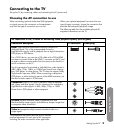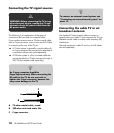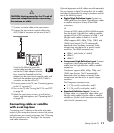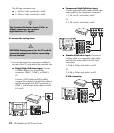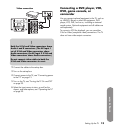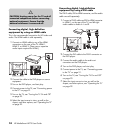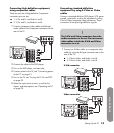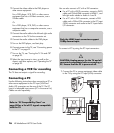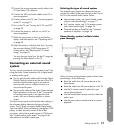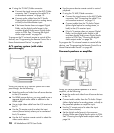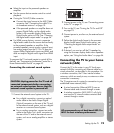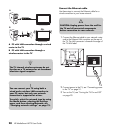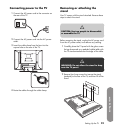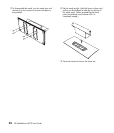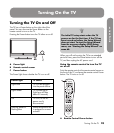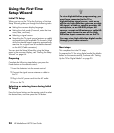
Setting Up the TV
Setting Up the TV 17
2
Connect the source equipment audio cable to the
PC Input Audio L/R connector.
3 Connect the VGA and audio cables to the PC or
source equipment.
4 Connect power to the TV; see “Connecting power
to the TV” on page 21.
5 Turn on the TV; see “Turning the TV On and Off”
on page 23.
6 Connect the power to, and turn on, the PC or
source equipment.
7 Select the input source to view, as well as the
Aspect, and other options; see “Operating the TV”
on page 29.
8 Adjust the picture, including Auto Sync, by using
the onscreen display (OSD) Picture menu PC
Screen option; see “Adjusting the PC Screen
image” on page 53.
You can also start Auto Sync for the PC image by
pressing the Select button on the TV.
Connecting an external sound
system
You can connect an external sound system to the TV by
using the Audio Output connectors for a digital audio
or analog audio signal:
■ Use an optical audio cable and the Audio Output
Digital (Optical) connector on the rear of the TV to
provide a digital audio signal to an external
sound system, such as a digital receiver or a
surround sound system.
■ Use an audio cable and the Audio Output Left and
Right connectors on the rear of the TV to provide
an analog audio signal to an external sound
system, such as an analog amplifier or stereo
system.
The input source signal and the Audio menu settings in
the onscreen display determine the type of audio
output. This TV does not support Dolby Digital audio
input over HDMI. When connecting a set-top box, DVD
player, or other device by means of the HDMI
connector, set the device audio output to PCM format.
See “Understanding audio output” on page 54 for
information on the audio output type.
Selecting the type of sound system
The external sound system can determine how you
connect the video/audio input sources to the TV and
the TV to the external audio system. Select:
■ Home theater system, see “Home theater system
(without video pass-through)” on page 17.
■ A/V receiver system, see “A/V receiver system
(with video pass-through)” on page 18.
■ Powered speakers or Amplifier, see “Powered
speakers or amplifier” on page 18.
Home theater system (without video
pass-through)
When you have a home theater system without video
pass-through, do the following:
■ Route the audio from all source devices to the
home theater.
■ Route the video from all source devices to the TV.
■ Use the TV remote control to select the input
source (Source button).
■ Use the home theater remote control to select the
audio input.
■ Use the source device remote control to control
playback.



